初中英语八大时态结构及用法
- 格式:docx
- 大小:69.05 KB
- 文档页数:13
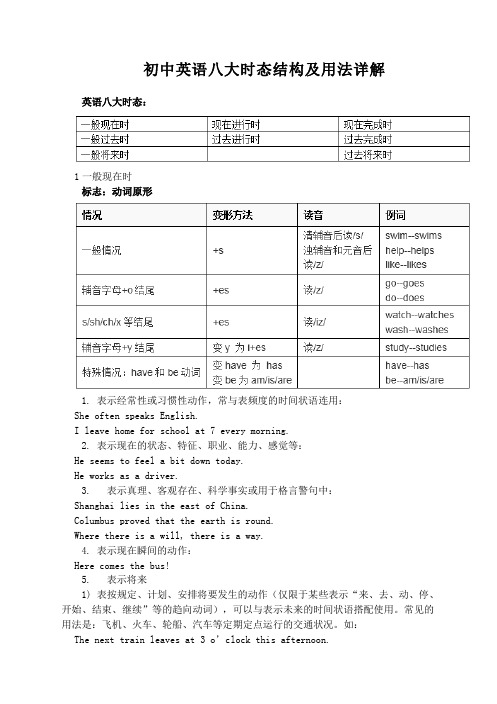
初中英语八大时态结构及用法详解英语八大时态:1一般现在时标志:动词原形1. 表示经常性或习惯性动作,常与表频度的时间状语连用:She often speaks English.I leave home for school at 7 every morning.2. 表示现在的状态、特征、职业、能力、感觉等:He seems to feel a bit down today.He works as a driver.3. 表示真理、客观存在、科学事实或用于格言警句中:Shanghai lies in the east of China.Columbus proved that the earth is round.Where there is a will, there is a way.4. 表示现在瞬间的动作:Here comes the bus!5. 表示将来1) 表按规定、计划、安排将要发生的动作(仅限于某些表示“来、去、动、停、开始、结束、继续”等的趋向动词),可以与表示未来的时间状语搭配使用。
常见的用法是:飞机、火车、轮船、汽车等定期定点运行的交通状况。
如:The next train leaves at 3 o’clock this afternoon.How often does the shuttle bus run?2) 在时间和条件状语从句中常使用一般现在时表示将来发生的事情:When Bill comes (不用will come), ask him to wait for me.I shall go there tomorrow unless I’m too busy.2一般过去时标志:动词过去式*闭音节:元音字母a, e, i, o, u如果发字母本来的音则称为开音节,否则称为闭音节。
1. 表示过去某时所发生的动作或存在的状态,常与表示过去的时间状语连用(e.g. yesterday, this morning, just now, a moment ago, in May, last night / year / week, once upon a time, the other day, before …, when …, in the past等)。

英语中常见的八大时态(结构及用法)1、一般现在时定义:经常、反复发生的动作或行为及现在的某种状况。
常和often、always等连用。
结构:主语+be(am/are/is)+或者是主语+实义动词/三单动词+例句:I go to school every day.我每天都去上学。
She goes to school every day. 她每天都上学。
2、一般过去时定义:表示过去某一时候或某一段时间所发生了的事情或存在的状态。
常和last week、yesterday等连用。
结构:主语+be(was/were)+或者是主语+实义动词过去式+例句:I went to the zoo yesterday. 我昨天去动物园了。
3、现在进行时定义:表示现阶段或说话时正在进行的动作及行为。
常和now等连用。
结构:主语+助动词be(am/are/is)+动词-ing形式+例句:I'm doing my homework. 我在做作业。
4、过去进行时定义:表示在过去某个时间点发生或进行的行为的事情。
常和at this time yesterday等或以when引导的谓语动词连用。
结构:主语+助动词be(was/were)+动词-ing形式+例句:When I got to the top of the mountain, the sun was shining. 我到达山顶时,阳光灿烂。
5、现在完成时定义:表示过去发生的动作对现在造成的影响或结果或过去的动作或状态持续到现在。
构成:主语+助动词(have/has)+动词过去分词+例句:I have lived here for more than twenty years. 我住在这儿二十多年了。
6、过去完成时定义:表示在过去某一时刻或动作以前完成了的动作,也可以说过去的时间关于过去的动作。
构成:主语+助动词(have/has)+动词过去分词+例句:She said she had never been to Paris. 她告诉我她曾去过巴黎。

初中英语八大时态结构及用法时态是表示行为、动作和状态在各种时间条件下的动词形式。
因此,时态结构包括一般现在时、一般过去时、一般将来时、现在进行时、过去进行时、将来进行时、现在完成时和过去完成时的结构及用法。
1. 一般现在时:表示通常性、规律性、习惯性、真理性的动作或状态。
结构:主语+动词原形(主语是第三人称单数时,动词要用第三人称单数形式)用法:表示经常发生的事情、存在的状态或客观真理。
2. 一般过去时:表示过去某个时间里发生的动作或状态。
结构:主语+动词过去式用法:表示过去发生的动作或存在的状态。
3. 一般将来时:表示将来发生的动作或存在的状态及打算、计划或准备做某事。
结构:主语+am/is/are going to+动词原形;主语+will/shall+动词原形用法:表示将要发生的动作或存在的状态。
4. 现在进行时:表示现阶段或说话时正在进行的动作及行为。
结构:主语+am/is/are+现在分词用法:表示正在进行的动作。
5. 过去进行时:表示过去某段时间或某一时刻正在发生或进行的动作或行为。
结构:主语+was/were+现在分词用法:表示过去正在进行的动作。
6. 将来进行时:表示将来某一时刻正在进行的动作,或表示要在将来某一时刻开始,并继续下去的动作。
结构:主语+shall/will+be+现在分词用法:表示将来正在进行的动作。
7. 现在完成时:表示过去发生的动作对现在造成的影响或结果,或表示过去的动作或状态持续到现在。
结构:主语+have/has+过去分词用法:表示已经完成的动作或存在的状态。
8. 过去完成时:表示在过去某一时刻或动作以前已经完成了的动作或存在的状态。
结构:主语+had+过去分词用法:表示过去已经完成的动作。

`:一般现在时英语中的八大时态定义:表示主语反复、经常、习惯性的动作。
句型结构`+V2.实义动词(行为动词)(在肯定句中,在实义动词前加do/does 用来表示强调,以加强句子的语气)2.否定句主语+don’t / doesn't+动词原形+其他3.一般疑问句Do / Does+主语+动词原形+其他4.肯定回答Yes,主语+do / does5.否定回答No,主语+don’t / doesn't用法|1.表示主语的特征或状态。
2.表示客观真理和客观事实。
3.在以when+句子,as soon as+句子,not…until, if+句子的句型中,用主将从现。
4.在以here , there 开头引导的倒装句中,通常采用一般现在时表示正在发生的动作。
时间状语(标志词)1. every+表时间n. on +星期2. 频率副词always usually often sometimes seldom never3. in the moring / afternoon / evening&形式1一般情况下,在动词末尾+s。
2以s x sh ch结尾的动词+es。
3以辅音字母加y结尾的动词,把y改为i 加es。
4以o结尾的单词有生命的+s没生命的加es。
5特殊的be 改为am is are。
&现在进行时定义表示主语的动作正在进行的句子^用法1.表示此时此刻正在进行的动作2.表示现阶段正在进行的动作或持续的状态句型结构1.肯定句:S + am/is/are + Ving2.否定句:S+ am/is/are + not + Ving3.一般疑问句:Am/Is/Are + S + Ving4.肯定回答Yes,S+ am/is/are5.否定回答NO,S + am/is/are + not>形式1如果动词以不发音字母e结尾ie,应先去e加ing2如果动词时只有一个辅音字母结尾的重读闭音节结尾,应双写该辅音字母再加ing3一般情况下,直接加ing时间状语(标志词)Look! Listen! now, at the moment, these days, can you see, can’t you see$注意事项:, come, get, go, have, leave, meet, play, return, see, spend, start, stay, wear, work等词用现在进行时表示将来。
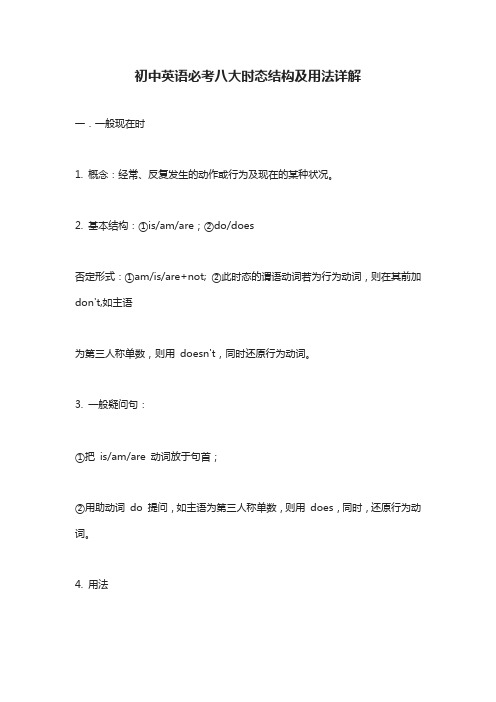
初中英语必考八大时态结构及用法详解一.一般现在时1. 概念:经常、反复发生的动作或行为及现在的某种状况。
2. 基本结构:①is/am/are;②do/does否定形式:①am/is/are+not; ②此时态的谓语动词若为行为动词,则在其前加don't,如主语为第三人称单数,则用doesn't,同时还原行为动词。
3. 一般疑问句:①把is/am/are 动词放于句首;②用助动词do 提问,如主语为第三人称单数,则用does,同时,还原行为动词。
4. 用法1)经常性或习惯性的动作,常与表示频度的时间状语连用。
例如:I leave home for school at 7 every morning. 每天早上我七点离开家。
2)客观真理,客观存在,科学事实。
例如:The earth moves around the sun. 地球绕太阳转动。
Shanghai lies in the east ofChina. 上海位于中国东部。
3)表示格言或警句。
例如:Pride goes before a fall 骄者必败。
注意:此用法如果出现在宾语从句中,即使主句是过去时,从句谓语也要用一般现在时。
例如:Columbus proved that the earth is round. 哥伦布证实了地球是圆的。
4)现在时刻的状态、能力、性格、个性。
例如:I don't want so much. 我不要那么多。
Ann writes good English but does not speak well.安英语写得不错,讲的可不行。
5)一般现在时表示将来含义。
a. 下列动词come, go, arrive, leave, start, begin, return 的一般现在时可以表示将来,主要用来表示在时间上已确定或安排好的事情。
例如:The train leaves at six tomorrow morning. 火车明天上午六点开。

(一)一般现在时1. 概念:经常、反复发生的动作或行为及现在的某种状况。
2. 基本结构:①is/am/are;②do/does否定形式:①am/is/are+not;②此时态的谓语动词若为行为动词,则在其前加don't,如主语为第三人称单数,则用doesn't,同时还原行为动词。
3. 一般疑问句:①把is/am/are动词放于句首;②用助动词do提问,如主语为第三人称单数,则用does,同时,还原行为动词。
4. 用法1) 经常性或习惯性的动作,常与表示频度的时间状语连用。
例如:I leave home for school at 7 every morning. 每天早上我七点离开家。
2) 客观真理,客观存在,科学事实。
例如:The earth moves around the sun. 地球绕太阳转动。
Shanghai lies in the east of China. 上海位于中国东部。
3) 表示格言或警句。
例如:Pride goes before a fall. 骄者必败。
注意:此用法如果出现在宾语从句中,即使主句是过去时,从句谓语也要用一般现在时。
例如:Columbus proved that the earth is round. 哥伦布证实了地球是圆的。
4) 现在时刻的状态、能力、性格、个性。
例如:I don't want so much. 我不要那么多。
Ann writes good English but does not speak well.安英语写得不错,讲的可不行。
5) 一般现在时表示将来含义a. 下列动词come, go, arrive, leave, start, begin, return的一般现在时可以表示将来,主要用来表示在时间上已确定或安排好的事情。
例如:The train leaves at six tomorrow morning. 火车明天上午六点开。
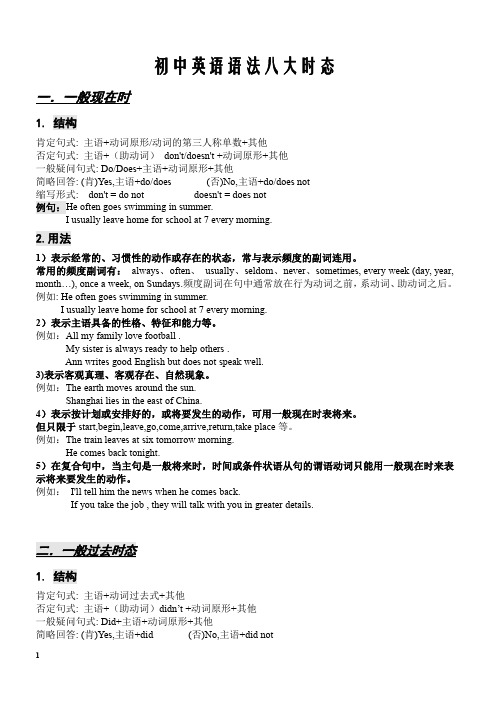
初中英语语法八大时态一.一般现在时1.结构肯定句式:主语+动词原形/动词的第三人称单数+其他否定句式:主语+(助动词)don't/doesn't+动词原形+其他一般疑问句式:Do/Does+主语+动词原形+其他简略回答:(肯)Yes,主语+do/does(否)No,主语+do/does not缩写形式:don't=do not doesn't=does not例句:He often goes swimming in summer.I usually leave home for school at7every morning.2.用法1)表示经常的、习惯性的动作或存在的状态,常与表示频度的副词连用。
常用的频度副词有:always、often、usually、seldom、never、sometimes,every week(day,year, month…),once a week,on Sundays.频度副词在句中通常放在行为动词之前,系动词、助动词之后。
例如:He often goes swimming in summer.I usually leave home for school at7every morning.2)表示主语具备的性格、特征和能力等。
例如:All my family love football.My sister is always ready to help others.Ann writes good English but does not speak well.3)表示客观真理、客观存在、自然现象。
例如:The earth moves around the sun.Shanghai lies in the east of China.4)表示按计划或安排好的,或将要发生的动作,可用一般现在时表将来。
但只限于start,begin,leave,go,come,arrive,return,take place等。
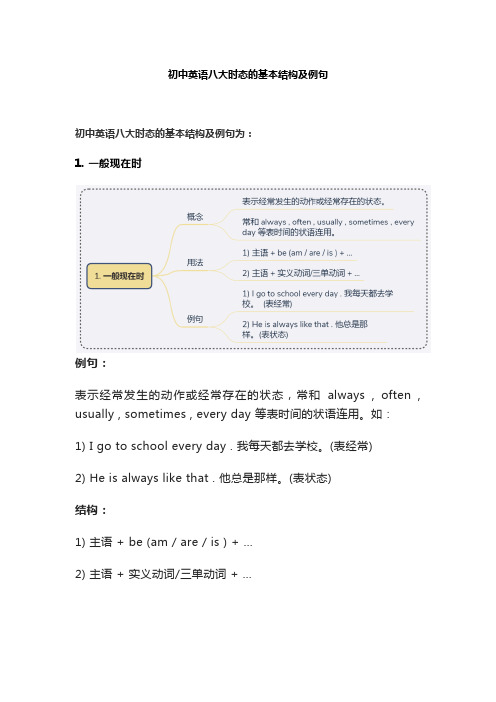
初中英语八大时态的基本结构及例句初中英语八大时态的基本结构及例句为:1. 一般现在时例句:表示经常发生的动作或经常存在的状态,常和always , often , usually , sometimes , every day 等表时间的状语连用。
如:1) I go to school every day . 我每天都去学校。
(表经常)2) He is always like that . 他总是那样。
(表状态)结构:1) 主语 + be (am / are / is ) + …2) 主语 + 实义动词/三单动词 + …2. 现在进行时例句:表示现在(说话瞬间)正在进行或发生的动作。
如:1) He is singing. 他正在唱歌。
2) They are watching TV now. 他们正在看电视。
结构:主语 + 助动词be(am/are/is) + 动词-ing形式结构3. 一般将来时例句:表示将来某个时间要发生的动作或存在的状态,也表示将来经常或反复发生的动作,常与表示将来的时间状语连用,如: tomorrow, next week, next year, in the future等。
如:1) He will go shopping tomorrow. 他明天要去购物。
2)They are going to play basketball next week. 他们下周要去打篮球。
结构:1) 主语 + 助动词will + 动原 + …2) 主语 + be going to + 动原 + ….4.一般过去时例句:1) 表示过去某个时间发生的动作或存在的状态,常和表示过去的时间状语连用。
如: yesterday , last week , in 1998 , two days ago 等。
如: I went to a movie yesterday. 我昨天去看了一场电影。
2) 也可表示过去经常或反复发生的动作。
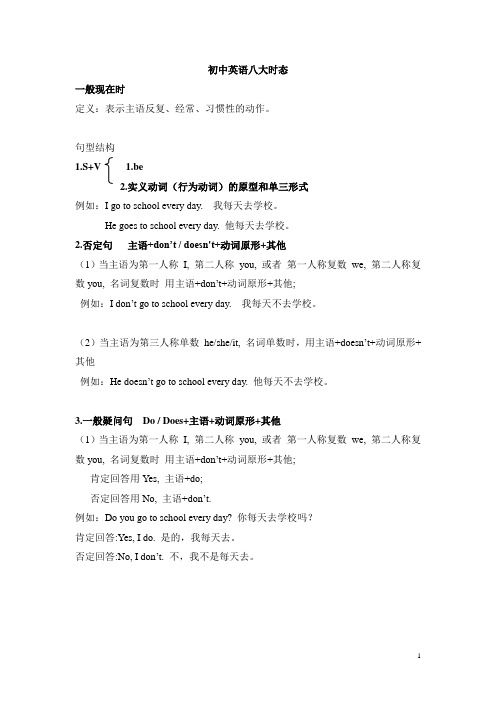
初中英语八大时态一般现在时定义:表示主语反复、经常、习惯性的动作。
句型结构1.S+V 1.be2.实义动词(行为动词)的原型和单三形式例如:I go to school every day. 我每天去学校。
He goes to school every day. 他每天去学校。
2.否定句主语+don’t / doesn't+动词原形+其他(1)当主语为第一人称I, 第二人称you, 或者第一人称复数we, 第二人称复数you, 名词复数时用主语+don’t+动词原形+其他;例如:I don’t go to school every day. 我每天不去学校。
(2)当主语为第三人称单数he/she/it, 名词单数时,用主语+doesn’t+动词原形+其他例如:He doesn’t go to school every day. 他每天不去学校。
3.一般疑问句Do / Does+主语+动词原形+其他(1)当主语为第一人称I, 第二人称you, 或者第一人称复数we, 第二人称复数you, 名词复数时用主语+don’t+动词原形+其他;肯定回答用Yes, 主语+do;否定回答用No, 主语+don’t.例如:Do you go to school every day? 你每天去学校吗?肯定回答:Yes, I do. 是的,我每天去。
否定回答:No, I don’t. 不,我不是每天去。
(2)(2)当主语为第三人称单数he/she/it, 名词单数时,用主语+doesn’t+动词原形+其他肯定回答用Yes, 主语+does;否定回答用No, 主语+doesn’t.例如:Does he go to school every day. 他每天去学校吗?肯定回答:Yes, he does. 是的,他每天去。
否定回答:No, he doesn’t. 不,他不是每天去。
用法1.表示主语的特征或状态。
2.表示客观真理和客观事实。

初中英语语法八大时态一.一般现在时1.结构肯定句式: 主语+动词原形/动词的第三人称单数+其他否定句式: 主语+(助动词)don't/doesn't +动词原形+其他一般疑问句式: Do/Does+主语+动词原形+其他简略回答: (肯)Yes,主语+do/does (否)No,主语+do/does not缩写形式: don't = do not doesn't = does not例句:He often goes swimming in summer.I usually leave home for school at 7 every morning.2.用法1)表示经常的、习惯性的动作或存在的状态,常与表示频度的副词连用。
例如: He often goes swimming in summer.I usually leave home for school at 7 every morning.2)表示主语具备的性格、特征和能力等。
例如:All my family love football .My sister is always ready to help others .Ann writes good English but does not speak well.3)表示客观真理、客观存在、自然现象。
例如:The earth moves around the sun.Shanghai lies in the east of China.4)表示按计划或安排好的,或将要发生的动作,可用一般现在时表将来。
但只限于start,begin,leave,go,come,arrive,return,take place等。
例如:The train leaves at six tomorrow morning.He comes back tonight.5)在复合句中,当主句是一般将来时,时间或条件状语从句的谓语动词只能用一般现在时来表示将来要发生的动作。

初中英语必考八大时态结构及用法详解初中英语八大时态的结构及用法如下:1. 现在一般时态:基本结构为动词的原型(第三人称单数时动词后面+s, es)。
表示“现在发生的动作、情况、状态和特征”。
常与now,today,this week等时间状语连用。
2. 过去一般时态:基本结构为动词的过去式(动词的过去式在规则动词中直接在原形词尾加-d或-ed,在词尾是e的直接加d,以“辅音字母+y”结尾的动词,先将y改为i,再加-ed)。
表示“过去发生的动作或存在的状态”。
常与yesterday,last week等时间状语连用。
3. 现在进行时态:基本结构为be(am/is/are)+动词的现在分词(动词后面+ing)。
表示“现在正在进行的动作”。
常与now,at the moment等时间状语连用。
4. 过去进行时态:基本结构为was/were+动词的现在分词(动词后面+ing)。
表示“过去正在进行的动作”。
常与at this time yesterday等时间状语连用。
5. 现在完成时态:基本结构为have/has+过去分词(动词后面+ed)。
表示“过去的动作对现在造成的影响或结果”。
常与already,yet,so far等副词连用。
6. 过去完成时态:基本结构为had+过去分词(动词后面+ed)。
表示“过去的动作在过去的某个时间之前已经完成或发生的动作或存在的状态”。
常与by the end of last year,by the time of等时间状语连用。
7. 现在完成进行时态:基本结构为have/has been+动词的现在分词(动词后面+ing)。
表示“动作从过去某时开始,一直延续到现在,或者刚刚完成”。
常与for several days,since等时间状语连用。
8. 过去完成进行时态:基本结构为had been+动词的现在分词(动词后面+ing)。
表示“过去的某个动作从过去某时开始,一直延续到过去的某个时间,或者刚刚完成”。

初中英语八大时态笔记以下是初中英语的八大时态笔记:1、一般现在时用法:表示习惯、经常性动作;表示现在的状态、性格、能力。
结构:be动词(am/is/are)+动词原形(如:I am a student.)2、现在进行时用法:表示此时此刻正在进行的动作或状态。
结构:be动词(am/is/are)+动词的现在分词(ing形式,如:he is studying.)3、现在完成时用法:表示过去发生的动作对现在造成的影响或结果。
结构:have/has+动词的过去分词(如:I have finished my homework.)4、现在完成进行时用法:表示从过去开始一直持续到现在的动作或状态。
结构:have/has+been+动词的现在分词(如:I have been studying for two hours.)5、一般过去时用法:表示过去某个时间发生的动作或状态。
结构:动词的过去式(如:I went to the park yesterday.)6、过去进行时用法:表示过去某个时间正在进行的动作或状态。
结构:was/were+动词的现在分词(如:I was watching TV at 8 o'clock yesterday.)7、过去完成时用法:表示在过去某个时间之前已经完成的动作或状态。
结构:had+动词的过去分词(如:I had finished my homework before dinner.)8、过去完成进行时用法:表示在过去某个时间之前一直持续到那个时间的动作或状态。
结构:had been+动词的现在分词(如:I had been studying for two hours before dinner.)。
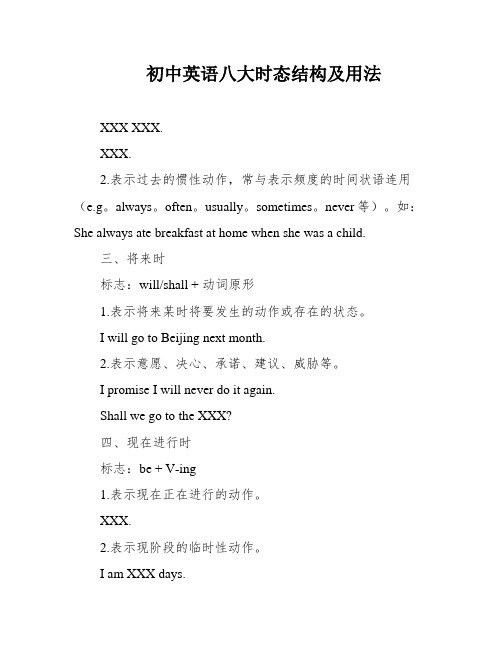
初中英语八大时态结构及用法XXX XXX.XXX.2.表示过去的惯性动作,常与表示频度的时间状语连用(e.g。
always。
often。
usually。
sometimes。
never等)。
如:She always ate breakfast at home when she was a child.三、将来时标志:will/shall + 动词原形1.表示将来某时将要发生的动作或存在的状态。
I will go to Beijing next month.2.表示意愿、决心、承诺、建议、威胁等。
I promise I will never do it again.Shall we go to the XXX?四、现在进行时标志:be + V-ing1.表示现在正在进行的动作。
XXX.2.表示现阶段的临时性动作。
I am XXX days.五、过去进行时标志:was/were + V-ing表示过去某一时刻正在进行的动作。
I was XXX it started to rain.六、现在完成时标志:have/has + 过去分词1.表示过去发生的动作对现在造成的影响或结果。
I have finished my homework。
so I can watch TV now.2.表示动作已经完成,强调完成的结果。
He has written three XXX.七、过去完成时标志:had + 过去分词表示过去某一时刻之前已经完成的动作。
I had XXX XXX.八、将来完成时标志:will have + 过去分词表示将来某一时刻之前已经完成的动作。
By next year。
I will have graduated from university。
时态在英语中是非常重要的语法内容,学好时态基本上就能够掌握语法的大半部分。
英语共有八种时态,分别是一般现在时、一般过去时、将来时、现在进行时、过去进行时、现在完成时、过去完成时和将来完成时。
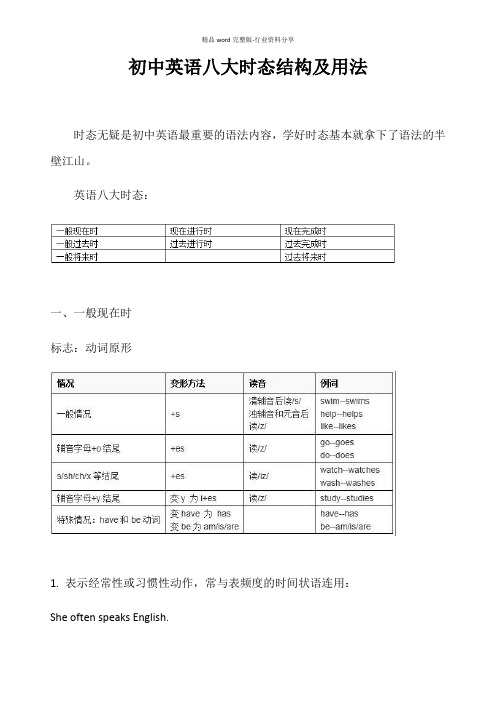
初中英语八大时态结构及用法时态无疑是初中英语最重要的语法内容,学好时态基本就拿下了语法的半壁江山。
英语八大时态:一、一般现在时标志:动词原形1. 表示经常性或习惯性动作,常与表频度的时间状语连用:She often speaks English.I leave home for school at 7 every morning.2. 表示现在的状态、特征、职业、能力、感觉等:He seems to feel a bit down today.He works as a driver.3. 表示真理、客观存在、科学事实或用于格言警句中:Shanghai lies in the east of China.Columbus proved that the earth is round.Where there is a will, there is a way.4. 表示现在瞬间的动作:Here comes the bus!5. 表示将来:1)表按规定、计划、安排将要发生的动作(仅限于某些表示“来、去、动、停、开始、结束、继续”等的趋向动词),可以与表示未来的时间状语搭配使用。
常见的用法是:飞机、火车、轮船、汽车等定期定点运行的交通状况。
如:The next train leaves at 3 o’clock this afternoon.How often does the shuttle bus run?2)在时间和条件状语从句中常使用一般现在时表示将来发生的事情:When Bill comes(不用will come)ask him to wait for me.I shall go there tomorrow unless I’m too busy.二、一般过去时标志:动词过去式闭音节:元音字母a, e, i, o, u如果发字母本来的音则称为开音节,否则称为闭音节。
1. 表示过去某时所发生的动作或存在的状态,常与表示过去的时间状语连用(e.g. yesterday, this morning, just now, a moment ago, in May, last night / year / week, once upon a time, the other day, before …, when …, in the past等)。

初中英语必考八大时态结构及用法详解一、一般现在时1. 概念:经常、反复发生的动作或行为及现在的某种状况。
2. 基本结构:①is/am/are;②do/does否定形式:①am/is/are+not;②此时态的谓语动词若为行为动词,则在其前加don't,如主语为第三人称单数,则用doesn't,同时还原行为动词。
3. 一般疑问句:①把is/am/are动词放于句首;②用助动词do提问,如主语为第三人称单数,则用does,同时,还原行为动词。
4. 用法1) 经常性或习惯性的动作,常与表示频度的时间状语连用。
例如:I leave home for school at 7 every morning. 每天早上我七点离开家。
2) 客观真理,客观存在,科学事实。
例如:The earth moves around the sun. 地球绕太阳转动。
Shanghai lies in the east ofChina. 上海位于中国东部。
3) 表示格言或警句。
例如:Pride goes before a fall. 骄者必败。
注意:此用法如果出现在宾语从句中,即使主句是过去时,从句谓语也要用一般现在时。
例如:Columbus proved that the earth is round. 哥伦布证实了地球是圆的。
4) 现在时刻的状态、能力、性格、个性。
例如:I don't want so much. 我不要那么多。
Ann writes good English but does not speak well.安英语写得不错,讲的可不行。
5) 一般现在时表示将来含义a. 下列动词come, go, arrive, leave, start, begin,return的一般现在时可以表示将来,主要用来表示在时间上已确定或安排好的事情。
例如:The train leaves at six tomorrow morning. 火车明天上午六点开。

初中英语必考八大时态结构及用法详解一、一般现在时(Simple Present Tense):用法1:表示经常性的、重复性的动作或状态,相当于中文的“经常/总是/通常/偶尔……”。
例句:1. I often go hiking on weekends.(我经常在周末去远足。
)2. They usually play soccer after school.(他们放学后通常踢足球。
)用法2:表示客观真理、科学道理或普遍规律。
例句:1. Water boils at 100 degrees Celsius.(水沸腾时的温度是100摄氏度。
)2. The sun rises in the east and sets in the west.(太阳东升西落。
)二、一般过去时(Simple Past Tense):用法1:表示过去一些时间发生的动作或存在的状态。
例句:1. We went to the beach yesterday.(昨天我们去了海滩。
)2. They lived in London last year.(去年他们住在伦敦。
)用法2:表示过去经常性或重复性的动作。
例句:1. When I was young, I often played hide-and-seek with my friends.(我小时候经常和朋友们玩捉迷藏。
)2. He used to visit his grandparents every summer.(他过去每个夏天都去看望他的祖父母。
)三、一般将来时(Simple Future Tense):用法1:表示将来发生的动作或存在的状态。
例句:1. I will go to the movie tonight.(今晚我将去看电影。
)2. She is going to visit her grandparents next month.(她下个月打算去看望她的祖父母。

初中英语8大时态结构及用法,赶快收藏!时态无疑是初中英语最重要的语法内容,学好时态基本就拿下了语法的半壁江山。
今天总结的八种时态是大家在初中阶段必学必考的,复习时一定要加倍重视哦!一、一般现在时1、概念:表示经常发生的情况;有规律出现的情况;总是发生的;和事实真理。
2.时间状语: Always, usually, often, sometimes, every week (day, year, month…), once a week (day, year, month…), on Sundays (on Mondays…)3.基本结构:动词原形(如主语为第三人称单数,动词上要改为第三人称单数形式)4.否定形式:主语+am / is / are+not+其他;此时态的谓语动词若为行为动词,则在其前加don't,如主语为第三人称单数,则用doesn't,同时还原行为动词。
5.一般疑问句:把be动词放于句首;用助动词do提问,如主语为第三人称单数,则用does,同时,还原行为动词。
eg:①It seldom snows here.这里很少下雪。
②He is always ready to help others.他总是乐于帮助别人。
③Action speaks louder than words.事实胜雄辩。
二、一般过去时1.概念:过去某个时间里发生的动作或状态;过去习惯性、经常性的动作、行为。
2.时间状语:ago, yesterday, the day before yesterday, last week, last (year,ni ght,month…), in 1989, just now, at the age of 5, one day, long long ago, once upon a time,etc.3.基本结构:主语+动词的过去式或 be 的过去式+名词4.否定形式:主语+was / were+not+其他;在行为动词前加didn't,同时还原行为动词。

八大时态的结构与用法
英语中主要有八大时态,它们的结构和用法如下:
- 现在时:表示经常性或习惯性的动作或状态,或者表示现在正在进行的动作。
常用的句式结构是:主语+动词原形+其他。
- 现在进行时:表示正在进行的动作,或者现在的某个动作正在发生。
常用的句式结构是:主语+be动词(am/is/are)+动词的现在分词+其他。
- 现在完成时:表示过去某个时间开始,一直持续到现在的动作或状态。
常用的句式结构是:主语+have/has+动词的过去分词+其他。
- 过去时:表示过去某个具体时间发生的动作或状态。
常用的句式结构是:主语+动词的过去式+其他。
- 过去进行时:表示过去某个具体时间正在进行的动作。
常用的句式结构是:主语+was/were+动词的现在分词+其他。
- 过去完成时:表示过去某个时间之前完成的动作。
常用的句式结构是:主语+had+动词的过去分词+其他。
- 将来时:表示将来某个时间会发生的动作或状态。
常用的句式结构是:主语+will+动词原形+其他。
- 将来进行时:表示将来某个具体时间正在进行的动作。
常用的句式结构是:主语+will be+动词的现在分词+其他。
初中英语八大时态结构及用法时态无疑是初中英语最重要的语法内容,学好时态基本就拿下了语法的半壁江山。
英语八大时态:一、一般现在时标志:动词原形1. 表示经常性或习惯性动作,常与表频度的时间状语连用:She often speaks English.I leave home for school at 7 every morning.2. 表示现在的状态、特征、职业、能力、感觉等:He seems to feel a bit down today.He works as a driver.3. 表示真理、客观存在、科学事实或用于格言警句中:Shanghai lies in the east of China.Columbus proved that the earth is round.Where there is a will, there is a way.4. 表示现在瞬间的动作:Here comes the bus!5. 表示将来:1)表按规定、计划、安排将要发生的动作(仅限于某些表示“来、去、动、停、开始、结束、继续”等的趋向动词),可以与表示未来的时间状语搭配使用。
常见的用法是:飞机、火车、轮船、汽车等定期定点运行的交通状况。
如:The next train leaves at 3 o’clock this afternoon.How often does the shuttle bus run?2)在时间和条件状语从句中常使用一般现在时表示将来发生的事情:When Bill comes(不用will come)ask him to wait for me.I shall go there tomorrow unless I’m too busy.二、一般过去时标志:动词过去式闭音节:元音字母a, e, i, o, u如果发字母本来的音则称为开音节,否则称为闭音节。
1. 表示过去某时所发生的动作或存在的状态,常与表示过去的时间状语连用(e.g. yesterday, this morning, just now, a moment ago, in May, last night / year / week, once upon a time, the other day, before …, when …, in the past等)。
如:Jim rang you just now.Liu Ying was in America last year.2. 表示过去经常或反复发生的动作,特别是used to do表达的句型,本身表示的就是过去常常。
如:When I was a kid, I often played football in the street.She used to visit her mother once a week.注意区分sb. used to do sth.(某人过去常常做某事,此处to是动词不定式标志符号)和sb. be used to sth./doing sth.(某人习惯于某物/做某事,此处to是介词)。
3. 代替一般现在时,表示一种婉转、客气、礼貌、商量的语气。
此用法仅适用于少数动词(如want, hope, wonder, think, intend等)及情态动词could, would。
如:I wondered if you could have a word with me.I hoped you could help me with my English.Would you mind my sitting here?4. 虚拟语气中用一般过去时表示现在或将来时间的动作或状态。
常用句型有:It is time that sb. did sth. “某人该做某事了”would rather sb. did sth. “宁愿某人做某事”三、一般将来时标志:will / shall + 动词原形1. 表示将来发生的动作或存在的状态,通常与表示将来的时间状语连用(e.g. tomorrow, next week, in the future等)。
如:We shall have a lot of rain next month.My husband will come back in a few days.2. 表示倾向性和习惯性:Fish will die without water.When it gets warmer, the snow will start to melt.3. 一般将来时的几种句式结构辨析:1)will / shall + 动词原形多用于表达主观愿望或必定会发生的事情(“将会如何”)shall作助动词时一般只用于第一人称2)be going to + 动词原形表示即将发生或打算要做的事:It is going to rain.We are going to have a meeting today.3)be to + 动词原形表示按计划或安排即将要发生的动作:He is to visit Japan next year.We are to discuss the report on Monday.4)be about to + 动词原形表示即将发生的动作,意为“马上要做某事”,后面一般不跟时间状语,如:The plane is about to start.Don’t worry. I am about to make a close examination on you.四、现在进行时标志:be + 动词的现在分词1. 表示说话时正在进行的动作:She is writing a letter upstairs.Who are you waiting for?It is raining hard.2. 表示现阶段一直在进行的动作(说话时动作未必正在进行):I hear Mr. Green is writing another novel.3. 表示反复出现或习惯性的动作,往往包含说话者赞扬、责备、厌恶等情绪,通常与always, constantly, continually, forever等频度副词连用。
如:John is forever asking silly questions like a stupid.He is always thinking of others first.4. 表示将来:1)表示按计划、安排将要发生的动作,仅适用于部分趋向动词(如go, come, leave, start, arrive等)。
如:Uncle Wang is coming.They're leaving for Beijing.2)在时间和条件状语从句中,现在进行时表示将来某时正在发生的事情。
如:Please drop in when you are passing my way.If he is still sleeping, don’t wake him up.五、过去进行时标志:was / were + 动词的现在分词1. 表示过去某一时刻或一段时间正在进行的动作,过去进行时中常用的时间状语有the whole morning, all day yesterday, from January toMarch last year等。
如:I was having a talk with Lucy at that time.They were watching TV at home last night.2. 表示过去反复出现或习惯性的动作,往往包含说话者赞扬、责备、厌恶等情绪,通常与always, constantly, continually, forever等频度副词连用。
如:My brother was always losing his keys.3. 表示按计划、安排过去某时刻将要发生的动作,仅适用于部分趋向动词(如go, come, leave, start, arrive等)。
如:He said they were leaving for Beijing this afternoon.4. 过去进行时有一个主要用法就是描述一件事情发生的背景(一个长动作延续的时候,另一个短动作发生):Granny fell asleep when she was reading.It was raining when they left the station.六、现在完成时标志:have / has + 动词的过去分词1. 表示一个过去发生并已完成的动作对现在产生影响或结果,强调的是现在的状况(表示“已完成”)。
如:He has left the city. (结果:他目前不在这个城市)Someone has broken the window. (结果:窗户破了)2. 表示一个动作开始于过去,持续到现在,也可能还会继续持续下去(表示“未完成”)。
I have been busy since last week.He has taught in our school for 30 years.I’ve finished half so far.注意:瞬间动词通常是不能用现在完成时表持续性的,但其否定结构则可以。
如:She hasn’t seen you for ages.His father hasn’t touched beer for a whole week.3. 表示过去到现在为止反复发生的动作或多次出现的状态,常与表示频度的副词always, often, every day等连用。
如:I have often heard that he is the cleverest person in that company.4. 在时间和条件状语从句中,现在完成时表示将来某时完成的动作。
如:I’ll go to your home when I have finished my homework.If it has stopped snowing in the morning, we’ll go the park.5. 与现在完成时连用的常见词语能与现在完成时连用的词语很多,just, already, yet, before, never, ever, recently等,但常见的有:1)since 自从I have been there many times since the war.We haven’t seen each other since last week.We have been friends ever since.2)in / for / during the past/last …years 在过去/最近…中I’ve been ill for the past three weeks.Great changes have take place in the last ten years.I have been here (for)the last/past month.3)so far 到目前为止We haven’t had any trouble so far.So far the search for the missing middle-aged woman has been fruitless. 4)up to/until now 到现在为止Up to now he’s been quiet.Up to now, the work has been easy.I have heard nothing from him up till now.Up till now we have planted over 2000 trees.5)It is/will be the first/second …time that …这是第一/二…次…It’s the first time (that)I’ve been here.It will be the first time (that)I’ve spoken in public.It is the second time (that)I have met him today.6)This is + 形容词最高级+ that …这是最…This is the best film that I’ve (ever)seen.6. 现在完成时与一般过去时的区别1)现在完成时强调对现在的影响和结果,与现在有联系;而一般过去时强调这个动作发生的时间是在过去,不涉及对现在的影响。